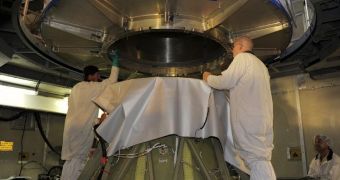NASA representatives from the Jet Propulsion Laboratory (JPL), in Pasadena, California, announce that the two spacecraft of the American space agency's GRAIL mission have been successfully integrated with their delivery system.
The mating procedure was carried out yesterday, August 18, at the Space Launch Complex 17 (SLC-17) facility. The launch pad is located at the Cape Canaveral Air Force Station (CCAFS), in Florida.
A Delta II launch vehicle will carry both spacecraft to Earth's orbit, from where they will be set on a course for the Moon. At 8:45 am EDT (5:45 am PDT, 1245 pm GMT) yesterday, the integration process was complete, with no incidents reported.
The GRAIL probes were first processed at the Titusville-based Astrotech Space Operations facility, which is located about 15 miles (25 kilometers) away from the CCAFS. After they were affixed to each other, the two instruments were sent to their launch pad, where the Delta II was already erected.
“We are about to finish one chapter in the GRAIL story and open another. Let me assure you this one is a real page-turner. GRAIL will rewrite the book on the formation of the Moon and the beginning of us,” Maria Zuber explains.
The expert is the principal investigator of the GRAIL mission to determine the structure of the lunar interior from crust to core. She holds an appointment as a professor at the Cambridge-based Massachusetts Institute of Technology (MIT).
According to JPL mission controllers, the spacecraft's launch window remains opened from September 8 all the way through October 19. Needless to say, NASA plans to launch the mission as soon as possible, so the final battery of tests and checks is scheduled to begin today, August 19.
The Gravity Recovery and Interior Laboratory (GRAIL) mission will enter a flight formation that will enable them to analyze the entire inner structure of the Moon, from its core to the outer layers of its crust, while at the same time studying its overall thermal evolution.
“GRAIL-A and GRAIL-B will fly in tandem orbits around the moon for several months to measure its gravity field in unprecedented detail,” a previous press release from the JPL team said.
“The mission will answer longstanding questions about Earth's moon, and provide scientists a better understanding of how Earth and other rocky planets in the solar system formed,” the team added. The JPL group is managing the mission for the NASA Science Mission Directorate in Washington DC.

 14 DAY TRIAL //
14 DAY TRIAL //